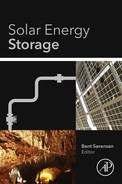Table of Contents
Chapter 1: Introduction and Overview
Part I: Solar Energy Storage Options
Chapter 2: Solar Electrical Energy Storage
2.2 Technical Requirements of a Solar Electrical Energy Storage Facility
2.3 Options for Solar Electrical Energy Storage Technologies
2.4 Utility-Scale Storage Technologies
2.5 Distributed Scale Storage Technologies—Rechargeable Batteries
2.6 Economics of Solar Electrical Energy Storage Technologies
Chapter 3: Innovative Systems for Storage of Thermal Solar Energy in Buildings
3.2 Major Technologies for Heat Storage in Buildings
3.3 Focus on a Solar Heat Absorption Storage System
Chapter 4: Assessment of Electricity Storage Systems
4.4 Requirements of ESS for Saudi Arabia
4.6 Assessment of ESS Technologies
4.7 Economic Evaluation of Selected ESS
4.8 Conclusions and Recommendations
5.2 Influencing Boundary Conditions
5.3 Classification of Solar Thermal Systems with TES
5.4 Case Study to Evaluate the Influence of the Diversity of Boundary Conditions
Chapter 6: Sorption Heat Storage
6.1 Characteristics of Different Types of Heat Storage
6.2 Principles of Sorption Heat Storage
6.3 Sorption Heat Storage Materials
6.4 Sorption Heat Storage System Designs
7.3 Evaluation of Complementarity in Time
7.4 Complementarity Between Solar Energy and Hydropower
7.5 Hydro-PV Hybrid Systems Based on Complementary Energy Resources
7.7 Effects of Complementarity in Time
7.8 Some Real Hybrid Systems with Partial Complementarity
Chapter 8: Revitalization of Hydro Energy: A New Approach for Storing Solar Energy
8.2 An Innovative Solution: Integration of a Solar-Hydro System
8.3 Geosynthetics as a Prerequisite for Hydro Energy Storage
8.4 Concept Integration of the SE-PSH System
8.5 Optimization Model of SE-PSH System
8.6 Impact Geosynthetics and Dynamic Charging and Discharging of PSH System
Part II: Economic Assessment of Solar Storage
Chapter 9: Photovoltaics and Storage Plants: Efficient Capacities in a System View
9.2 Storage Plants in a System View
Chapter 10: Economics of Solar PV Systems with Storage, in Main Grid and Mini-Grid Settings
10.2 Electricity Industry Economics
10.3 PV and Storage Applications
10.4 Possible Future Developments
Part III: Environmental and Social Impacts
Chapter 11: Environmental Issues Associated with Solar Electric and Thermal Systems with Storage
11.3 Solar Electricity Systems
Chapter 12: Consumer Perceptions and Acceptance of PV Systems with Energy Storage
12.2 Japanese Energy Policy, Including FiT
12.4 Consumer Perception Survey: Renewables and ESS in Japan
Chapter 13: Photovoltaic-Energy Storage Systems for Remote Small Islands
13.2 The Need for Energy Storage in Remote Islands
13.3 Operation Modes of a Typical ESS
13.4 Available Energy Storage Techniques
13.7 Representative Case Study
Chapter 14: Solar Thermal Energy Storage for Solar Cookers
14.3 Solar Cookers Using Sensible Heat Thermal Energy Storage (SHTES)
14.4 Solar Cookers Using LHTES
14.5 Characterization of Solar Cookers with TES
15.3 Existing Energy Consumption Patterns and Potential Electricity Demand
15.5 Technology Selection and Component Sizing
15.6 Levelized Cost of Electricity (LCOE)
15.7 Business Model for Mini-Grid Solar PV System
15.8 Operational and Management Model for the Solar Mini-Grid System
